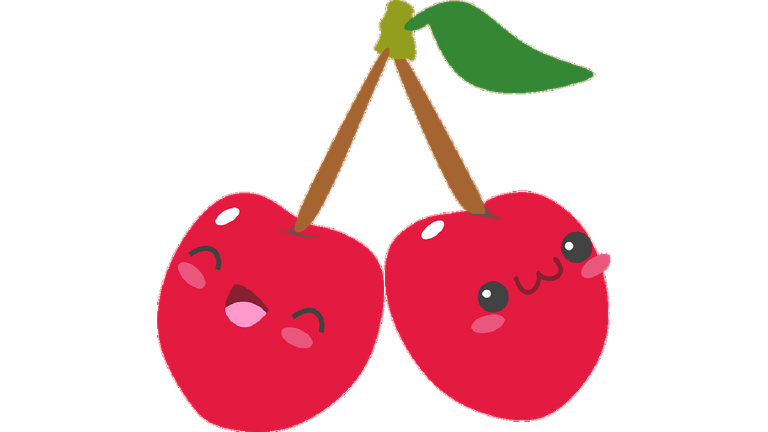Cherry -vs- Almond
It is nice when one eventually finds some justification for perceptions which other people find strange. In my younger days decades ago, I would frequently sample a cake or cookie that had a distinct cherry flavor to my tongue. Upon complimenting the person who made it, they often said that there was only almond extract in the recipe, not cherry. This was often revealed with a measure of disbelief on their part and a comment about my malfunctioning tastebuds.

image source: Julieta Mascarella on Unsplash.com
The justification came about in an indirect way. I happened to be watching a cooking show on television via the PBS (Public Broadcasting Service) network. Among the dishes they were making was a clafoutis (prounounced: klafoutee, the ending 's' is silent) — a dessert of French origin[4], of which I'd never heard. As usual, I had to do my own online research about it. The traditional clafoutis originated in the Limousin region of France and is made with cherries. Not only is the flesh of the cherry fruits used, but also the "nut-like kernels in the stones." [4]
Cherry kernels contain benzaldehyde, the compound responsible for the dominant flavour in almond extract. They also contain a small amount of amygdalin, a cyanogenic glycoside - a compound potentially capable of releasing cyanide if consumed, but non-toxic in small quantities. [2][4]
So, boom! 💥 There actually is a possible logical explanation of the bridging of cherry and almond flavors, and perhaps my tongue is somewhat more sensitive to the presence of benzaldehyde than some other people's tongues!
Naturally-occurring enzymes in the human body act upon benzaldehyde and the related compound amygdalin to release hydrogen cyanide. In small quantities, such as when eating a Clafoutis, there should not be any problem. But, ingesting large quantities can make one very ill, or even cause death.[3] For this reason, caution must be taken in general not to ingest cherry kernels, apple seeds, or orange seeds. Other foods that contain amygdalin include cassava (yuca, tapioca) and bamboo shoots, although proper processing (boiling or fermenting) before subsequent cooking can remove much of the harmful compounds.[4]
Almonds also have some amygdalin and benzaldehyde, too. In fact, the scientific name of almond trees is Prunus amygdalus, according to some botanists, and there is an almond-shaped structure within the human brain called the amygdala.[1] Some taxonomists use the taxonomic synonym Prunus dulcis for the almond tree, and they describe two varieties: (1) Prunus dulcis var. dulcis for the "sweet almond" and (2) Prunus dulcis var. amara for the "bitter almond." The former has smaller amounts of cyanide-producing compounds and is the variety cultivated for human consumption. The latter has more dangerous levels of cyanide-producing compounds and was once used medicinally, although that practice has been discouraged because of the the toxicity of the variety.[1]

I have always liked cherries, especially fresh ones. I've blogged before about the "sweet cherries" from Prunus avium trees, which are often available (when they're in season) in markets near me. The following photos appeared in this blog from Aug-2018, but I am reposting them here with updated Creative Commons licensing in case anyone wishes to use them.

These delightful fruits are pretty with their gorgeous, deep-red color. They are delicious, and a good source of dietary fiber as well as Vitamin-C. Besides these "sweet cherries" Prunus avium, I also love things flavored with "black cherry" (Prunus serotina), too. Again, though, the black cherry also contains benzaldehyde and amygdalin, so the kernels should not be consumed.[6]

Thank you for wandering with me through the fascinating world of cherries and almonds as we dodge the cyanide compounds! Sounds like a great idea for a video game, eh...? 😁
 😊
😊SOURCES
1 Wikipedia: Almond
2 Wikipedia: Benzaldehyde
3 Wikipedia: Cherry
4 Wikipedia: Clafoutis
5 Wikipedia: Cyanide Poisoning
6 Wikipedia: Prunus serotina











12-Aug-2021
!discovery 20
This post was shared and voted inside the discord by the curators team of discovery-it
Join our community! hive-193212
Discovery-it is also a Witness, vote for us here
Delegate to us for passive income. Check our 80% fee-back Program
To add to the taste-bud deceptions ... I learned a long time ago that Bitter-Almond Extract was made from peach pits. .... After reading your post, I went to Google University to find out ....
Of course, I found a decent answer on a sewing website??? here
and a video --
So ... you apparently can make almond extract from most of the fruits that have stones - but you always need to be careful that you release the cyanide. To avoid the cyanide ... just use almonds. Now, I might have to make some.
Thanks for your post - it took inspired me to dig a little deeper!!
@thekittygirl
View or trade
BEER.Hey @thekittygirl, here is a little bit of
BEERfrom @pixresteemer for you. Enjoy it!Learn how to earn FREE BEER each day by staking your
BEER.This post has received a 100.00% upvote from @fambalam! Join thealliance community to get whitelisted for delegation to this community service.
I have the same and I love both almond and cherry but strange that in pastery that’s so different to say what is what !
Fun to learn a new fact.
Fresh cherries here are a bit expensive but I buy them when I can and the kids eat yhammas candy
Awesome detective work @thekittygirl. Almond extract is a unique flavor (often overused) and it's interesting to read how it is made. It can also be one of those "secret ingredients" that give your recipe that flavor that can be hard to place.
I read that somewhere years ago that Almond Extract tasted like cherries. I didn't investigate to find out the scientific reason for this. I just started using the extract. In fact, it does taste like cherries. The flavor is wonderful for the added taste no one can recognize, but compliments me on. I use the extract extensively to bake.
Thanks for sharing.